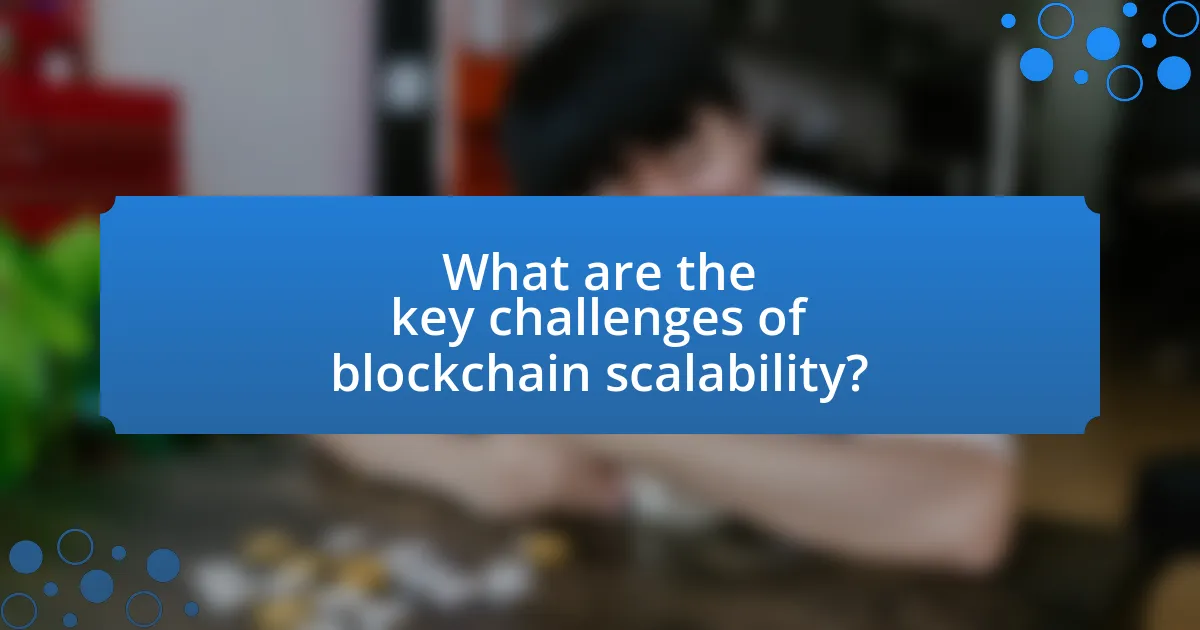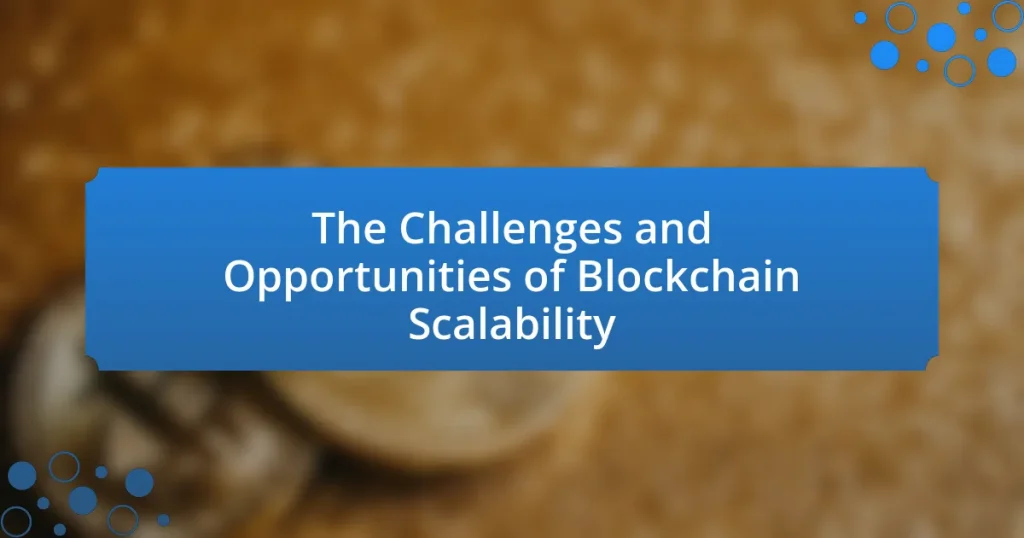The article focuses on the challenges and opportunities of blockchain scalability, highlighting key issues such as limited transaction throughput, high latency, and increased costs due to network congestion. It examines how transaction speed and throughput affect scalability, the limitations of current blockchain architectures, and the impact of decentralization on transaction processing times. Additionally, the article explores the trade-offs between scalability and security, the economic implications of scalability issues, and the potential benefits of layer 2 solutions, sharding, and innovative consensus mechanisms. Finally, it discusses future trends in blockchain scalability, including interoperability and the influence of emerging technologies like artificial intelligence and quantum computing.

What are the key challenges of blockchain scalability?
The key challenges of blockchain scalability include limited transaction throughput, high latency, and increased costs associated with network congestion. Limited transaction throughput arises because many blockchain networks, such as Bitcoin and Ethereum, can only process a finite number of transactions per second, often leading to bottlenecks during peak usage times. High latency occurs as the time taken to confirm transactions increases, particularly when the network is under heavy load. Additionally, increased costs manifest as transaction fees rise during periods of congestion, making it economically unfeasible for users to transact. These challenges hinder the ability of blockchain technology to support widespread adoption and large-scale applications.
How do transaction speed and throughput affect scalability?
Transaction speed and throughput directly influence scalability by determining how many transactions a blockchain can process within a given timeframe. High transaction speed allows for quicker confirmations, while greater throughput enables the handling of more transactions simultaneously. For instance, Bitcoin processes approximately 7 transactions per second, which limits its scalability compared to Ethereum, which can handle around 30 transactions per second. This difference illustrates that blockchains with higher transaction speeds and throughput can accommodate more users and applications, thereby enhancing scalability. Consequently, as demand increases, blockchains with lower transaction speeds and throughput may face congestion, leading to delays and higher fees, which further hampers their scalability potential.
What are the limitations of current blockchain architectures in handling transactions?
Current blockchain architectures face significant limitations in handling transactions, primarily due to scalability issues, transaction speed, and energy consumption. Scalability is constrained by the maximum number of transactions processed per second; for instance, Bitcoin can handle approximately 7 transactions per second, while Ethereum processes around 30. This limitation leads to network congestion during peak usage, resulting in delayed transactions and increased fees. Additionally, many blockchain systems rely on proof-of-work consensus mechanisms, which require substantial energy and computational resources, further hindering efficiency. These factors collectively restrict the ability of blockchain architectures to support high-volume transaction environments effectively.
How do network congestion and latency impact user experience?
Network congestion and latency significantly degrade user experience by causing delays and interruptions in service. When a network is congested, data packets experience increased queuing times, leading to slower response times for applications and services. For instance, a study by the Federal Communications Commission (FCC) found that high latency can result in a 50% drop in user satisfaction for online gaming and video streaming services. Additionally, latency issues can lead to timeouts and failed transactions, particularly in blockchain applications where timely confirmations are critical. This combination of congestion and latency can frustrate users, reduce engagement, and ultimately drive them away from services that rely on real-time interactions.
What role does decentralization play in scalability challenges?
Decentralization significantly impacts scalability challenges by distributing network resources and decision-making across multiple nodes, which can lead to increased latency and reduced transaction throughput. In decentralized systems, each node must validate transactions, creating bottlenecks as the number of users grows. For instance, Bitcoin’s decentralized model limits its transaction capacity to approximately seven transactions per second due to the time required for consensus among nodes. This contrasts with centralized systems, which can process thousands of transactions per second by relying on a single authority. Therefore, while decentralization enhances security and resilience, it simultaneously complicates scalability, necessitating innovative solutions like layer-2 protocols or sharding to improve performance without sacrificing the core benefits of decentralization.
How does maintaining decentralization affect transaction processing times?
Maintaining decentralization generally increases transaction processing times due to the need for consensus among multiple nodes. In decentralized networks, each transaction must be verified by numerous participants, which can lead to delays compared to centralized systems where a single entity processes transactions quickly. For instance, Bitcoin’s average transaction time is around 10 minutes, largely because it relies on a decentralized consensus mechanism called Proof of Work, which requires significant computational effort and time to validate transactions across the network. This inherent characteristic of decentralization, while enhancing security and trust, often results in slower transaction speeds, particularly during periods of high network activity.
What trade-offs exist between scalability and security in blockchain networks?
Scalability and security in blockchain networks often present trade-offs where enhancing one can compromise the other. For instance, increasing scalability typically involves reducing the amount of data each node must process, which can lead to weaker security measures, as fewer nodes may validate transactions, making the network more susceptible to attacks. A concrete example is the implementation of sharding, which improves transaction throughput but can expose the network to risks like data inconsistency and increased vulnerability to malicious actors. Additionally, protocols that prioritize speed, such as those using proof-of-stake, may sacrifice the robust security guarantees provided by proof-of-work systems, which require significant computational resources to deter attacks. Thus, while scalability enhances user experience and transaction speed, it can inadvertently lower the overall security of the blockchain network.
What are the economic implications of scalability issues?
Scalability issues in blockchain technology can lead to significant economic implications, primarily by limiting transaction throughput and increasing costs. When a blockchain network cannot efficiently handle a growing number of transactions, users may experience delays and higher fees, which can deter adoption and usage. For instance, during peak times, Ethereum’s transaction fees surged to over $50 per transaction in 2021, illustrating how scalability constraints can inflate costs and hinder economic activity. Additionally, businesses relying on blockchain for operations may face increased operational costs and reduced competitiveness, as they may need to invest in alternative solutions or technologies to manage scalability challenges. This can ultimately stifle innovation and economic growth within the blockchain ecosystem.
How do high transaction fees influence user adoption?
High transaction fees negatively influence user adoption by making blockchain services less accessible and appealing to potential users. When transaction costs are elevated, individuals and businesses may seek alternative platforms with lower fees, thereby limiting the growth of user bases on high-fee networks. For instance, during periods of high demand, Ethereum’s transaction fees have surged to over $50 per transaction, prompting users to migrate to cheaper alternatives like Binance Smart Chain or Solana. This trend illustrates that excessive fees can deter participation and hinder the overall scalability of blockchain ecosystems.
What impact do scalability challenges have on the overall market growth of blockchain technology?
Scalability challenges significantly hinder the overall market growth of blockchain technology by limiting transaction throughput and increasing latency. For instance, Bitcoin can process only about seven transactions per second, while Ethereum handles approximately 30, which constrains their ability to support large-scale applications. This limitation results in higher transaction fees and slower confirmation times during peak usage, discouraging businesses and developers from adopting blockchain solutions. Consequently, the inability to scale effectively stifles innovation and reduces the potential market size, as enterprises seek more efficient alternatives.

What opportunities exist for improving blockchain scalability?
Opportunities for improving blockchain scalability include the implementation of layer 2 solutions, sharding, and consensus algorithm enhancements. Layer 2 solutions, such as the Lightning Network for Bitcoin and Plasma for Ethereum, enable off-chain transactions that reduce the load on the main blockchain, thereby increasing transaction throughput. Sharding divides the blockchain into smaller, manageable pieces, allowing parallel processing of transactions, which significantly enhances scalability. Additionally, transitioning from proof-of-work to more efficient consensus algorithms like proof-of-stake can reduce energy consumption and increase transaction speeds. These methods have been validated by various blockchain projects that have successfully implemented them, demonstrating their effectiveness in addressing scalability challenges.
How can layer 2 solutions enhance scalability?
Layer 2 solutions enhance scalability by enabling off-chain transactions that reduce the load on the main blockchain. These solutions, such as state channels and rollups, allow multiple transactions to be processed outside the main chain, which significantly increases transaction throughput. For instance, Ethereum’s rollups can process thousands of transactions per second compared to the main chain’s limit of around 30 transactions per second. This offloading of transactions not only alleviates congestion but also lowers transaction fees, making the network more efficient and accessible for users.
What are the most promising layer 2 technologies currently in development?
The most promising layer 2 technologies currently in development include Optimistic Rollups, zk-Rollups, and state channels. Optimistic Rollups, such as those implemented by Arbitrum and Optimism, enhance Ethereum’s scalability by processing transactions off-chain while assuming they are valid unless proven otherwise. zk-Rollups, utilized by projects like zkSync, leverage zero-knowledge proofs to ensure transaction validity and significantly reduce on-chain data requirements. State channels, exemplified by the Lightning Network for Bitcoin, allow participants to conduct multiple transactions off-chain, settling only the final state on the blockchain, thus improving transaction speed and reducing costs. These technologies are gaining traction due to their ability to address scalability issues while maintaining security and decentralization.
How do these solutions address the limitations of layer 1 blockchains?
Solutions such as layer 2 scaling, sharding, and sidechains effectively address the limitations of layer 1 blockchains by enhancing transaction throughput and reducing latency. Layer 2 solutions, like the Lightning Network for Bitcoin, enable off-chain transactions, which alleviate congestion on the main blockchain and allow for faster processing times. Sharding divides the blockchain into smaller, manageable pieces, enabling parallel processing of transactions, which significantly increases scalability. Sidechains allow for the transfer of assets between different blockchains, thereby offloading some of the transaction volume from the main chain. These methods collectively improve the efficiency and scalability of blockchain networks, as evidenced by Ethereum’s transition to a proof-of-stake model and the implementation of sharding in its roadmap, which aims to increase transaction capacity from 30 transactions per second to potentially thousands.
What innovations in consensus mechanisms can improve scalability?
Innovations in consensus mechanisms that can improve scalability include sharding, proof of stake, and layer 2 solutions. Sharding divides the blockchain into smaller, manageable pieces, allowing multiple transactions to be processed simultaneously, which significantly increases throughput. Proof of stake reduces the energy consumption and time required for block validation compared to traditional proof of work, enabling faster transaction confirmations. Layer 2 solutions, such as the Lightning Network for Bitcoin, facilitate off-chain transactions that alleviate congestion on the main blockchain, further enhancing scalability. These innovations are supported by empirical evidence; for instance, Ethereum’s transition to proof of stake has shown a reduction in transaction times and costs, while sharding is projected to increase Ethereum’s capacity to thousands of transactions per second.
How do proof-of-stake and other alternative mechanisms compare to proof-of-work in terms of scalability?
Proof-of-stake and other alternative mechanisms generally offer superior scalability compared to proof-of-work. Proof-of-stake systems, such as Ethereum 2.0, can process transactions more efficiently because they do not require energy-intensive mining, allowing for faster block times and higher throughput. For instance, Ethereum 2.0 aims to achieve thousands of transactions per second, significantly outpacing Bitcoin’s proof-of-work, which typically handles around seven transactions per second. Additionally, mechanisms like delegated proof-of-stake and sharding further enhance scalability by enabling parallel processing of transactions, thus reducing congestion and improving overall network performance.
What are the potential benefits of sharding in blockchain scalability?
Sharding in blockchain scalability offers significant benefits, primarily by enhancing transaction throughput and reducing latency. By dividing the blockchain network into smaller, manageable pieces called shards, each shard can process transactions independently and simultaneously. This parallel processing capability allows for a substantial increase in the number of transactions that can be handled at any given time, addressing the scalability limitations of traditional blockchain architectures. For instance, Ethereum 2.0 aims to implement sharding to improve its transaction capacity from approximately 30 transactions per second to potentially thousands, thereby demonstrating the effectiveness of sharding in scaling blockchain networks.
How can interoperability between blockchains contribute to scalability?
Interoperability between blockchains can significantly enhance scalability by allowing multiple blockchains to communicate and share data seamlessly. This interconnectedness enables the distribution of workloads across various networks, reducing congestion on any single blockchain. For instance, when transactions can be processed on different chains, the overall throughput increases, allowing for a higher volume of transactions to be handled simultaneously. A study by the World Economic Forum highlights that interoperability can lead to a more efficient allocation of resources, as tasks can be offloaded to less congested networks, thereby improving transaction speeds and reducing costs.
What are the challenges and solutions for achieving cross-chain communication?
The challenges for achieving cross-chain communication include interoperability issues, security vulnerabilities, and scalability limitations. Interoperability issues arise because different blockchains often use distinct protocols and consensus mechanisms, making it difficult for them to communicate effectively. Security vulnerabilities can occur during cross-chain transactions, as the complexity of interactions increases the risk of exploits. Scalability limitations are evident when multiple chains attempt to process transactions simultaneously, leading to congestion and delays.
Solutions to these challenges involve the development of standardized protocols, such as the Inter-Blockchain Communication (IBC) protocol, which facilitates seamless interactions between different blockchains. Additionally, implementing cross-chain bridges can enhance security by allowing assets to move between chains without compromising their integrity. Layer 2 solutions, like state channels or sidechains, can also improve scalability by offloading transactions from the main chain, thus reducing congestion and increasing throughput.
How does interoperability enhance the overall efficiency of blockchain networks?
Interoperability enhances the overall efficiency of blockchain networks by enabling seamless communication and data exchange between different blockchain systems. This capability allows for the integration of diverse functionalities and services, which can lead to reduced transaction times and lower costs. For instance, when blockchains can interact, users can transfer assets across platforms without the need for intermediaries, thereby streamlining processes and improving user experience. Furthermore, studies indicate that interoperability can increase the overall throughput of blockchain networks by allowing them to share resources and information, thus optimizing performance and scalability.

What are the future trends in blockchain scalability?
Future trends in blockchain scalability include the adoption of Layer 2 solutions, sharding, and interoperability protocols. Layer 2 solutions, such as the Lightning Network for Bitcoin and Optimistic Rollups for Ethereum, enable faster transactions by processing them off the main blockchain while still ensuring security and decentralization. Sharding, which involves splitting the blockchain into smaller, manageable pieces, allows for parallel processing of transactions, significantly increasing throughput. Interoperability protocols, like Polkadot and Cosmos, facilitate communication between different blockchains, enhancing scalability by allowing them to share resources and data. These trends are supported by ongoing research and development in the blockchain space, indicating a strong movement towards more efficient and scalable systems.
How are emerging technologies influencing blockchain scalability?
Emerging technologies are significantly enhancing blockchain scalability by introducing solutions such as sharding, layer-2 protocols, and improved consensus mechanisms. Sharding divides the blockchain into smaller, manageable pieces, allowing parallel processing of transactions, which increases throughput. Layer-2 protocols, like the Lightning Network for Bitcoin, enable off-chain transactions that reduce the load on the main blockchain, thereby improving speed and efficiency. Additionally, advancements in consensus mechanisms, such as Proof of Stake, reduce energy consumption and increase transaction speeds compared to traditional Proof of Work systems. These innovations collectively address the scalability challenges faced by blockchain networks, as evidenced by Ethereum’s transition to a Proof of Stake model, which aims to enhance its transaction capacity and reduce congestion.
What role do artificial intelligence and machine learning play in optimizing blockchain performance?
Artificial intelligence and machine learning significantly enhance blockchain performance by improving transaction speed, security, and scalability. These technologies analyze vast amounts of data to identify patterns and optimize consensus algorithms, which can reduce the time required for transaction validation. For instance, AI can predict network congestion and adjust resource allocation dynamically, leading to more efficient processing. Additionally, machine learning algorithms can detect anomalies and potential security threats in real-time, thereby increasing the overall security of blockchain networks. Research indicates that integrating AI with blockchain can lead to a 30% improvement in transaction throughput, demonstrating the tangible benefits of this synergy.
How can quantum computing impact blockchain scalability in the future?
Quantum computing can significantly enhance blockchain scalability by enabling faster transaction processing and improved consensus mechanisms. Traditional blockchain systems face limitations in transaction throughput due to their reliance on classical computing power, which can be slow and resource-intensive. Quantum computers, leveraging principles of superposition and entanglement, can perform complex calculations at unprecedented speeds, potentially allowing for the validation of multiple transactions simultaneously.
For instance, quantum algorithms like Grover’s algorithm can search through unsorted databases exponentially faster than classical algorithms, which could streamline the process of transaction verification. Additionally, quantum computing could facilitate more efficient consensus protocols, reducing the time and computational resources required to achieve agreement among network participants.
Research indicates that as quantum technology matures, it could lead to the development of new blockchain architectures that inherently support higher scalability, addressing current bottlenecks. This transformative potential underscores the importance of preparing blockchain systems for a future where quantum computing plays a pivotal role in enhancing their performance and scalability.
What are the best practices for developers to enhance scalability in their blockchain projects?
To enhance scalability in blockchain projects, developers should implement sharding, layer 2 solutions, and optimize consensus mechanisms. Sharding divides the blockchain into smaller, manageable pieces, allowing parallel processing of transactions, which significantly increases throughput. Layer 2 solutions, such as state channels and sidechains, enable off-chain transactions that reduce the load on the main blockchain, thereby improving scalability. Additionally, optimizing consensus mechanisms, like transitioning from proof-of-work to proof-of-stake, can enhance transaction speeds and reduce energy consumption. These practices are supported by various blockchain implementations, such as Ethereum’s transition to Ethereum 2.0, which aims to improve scalability through these methods.
What strategies can be employed to balance scalability with security and decentralization?
To balance scalability with security and decentralization, implementing layer-2 solutions, such as state channels and sidechains, is effective. These solutions allow transactions to occur off the main blockchain, reducing congestion while maintaining security through cryptographic proofs. For instance, the Lightning Network for Bitcoin enables faster transactions without compromising the decentralized nature of the network. Additionally, adopting sharding techniques can enhance scalability by distributing data across multiple nodes, which preserves security and decentralization by ensuring that no single point of failure exists. Research indicates that these strategies can significantly improve transaction throughput while safeguarding the core principles of blockchain technology.
How can community engagement and feedback improve scalability solutions?
Community engagement and feedback can significantly enhance scalability solutions by ensuring that the needs and preferences of users are accurately understood and addressed. Engaged communities provide valuable insights into user experiences, which can inform the design and implementation of scalable systems. For instance, feedback from users can highlight specific bottlenecks or inefficiencies in existing solutions, allowing developers to prioritize improvements that directly impact user satisfaction and system performance. Research indicates that projects with active community involvement, such as Ethereum, often adapt more rapidly to user needs, resulting in more effective scalability strategies. This iterative process of incorporating community feedback leads to solutions that are not only technically sound but also widely accepted and utilized, ultimately driving greater adoption and scalability.


